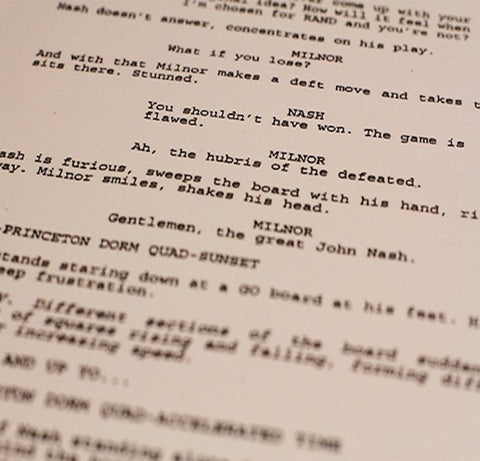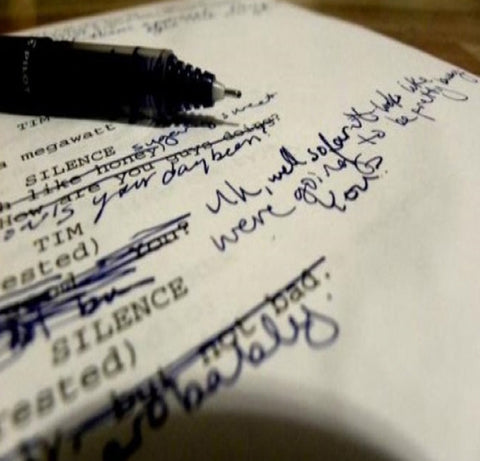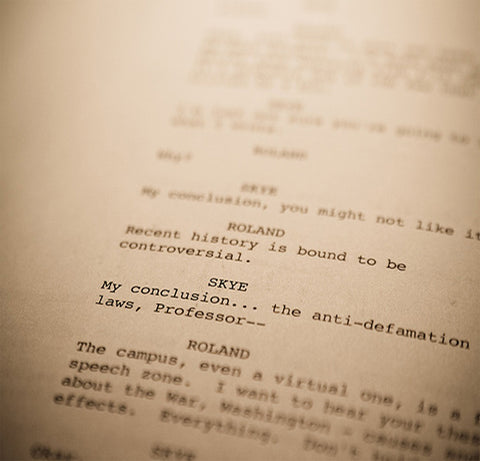structure RSS
GIMME GIMME GIMME
In story development there is a term: gimme. A gimme is a story beat that’s built on a coincidence. There are big gimmes and small gimmes. Typically, a well-constructed story has room for one big gimme. Even then, the big gimme is usually found in the set-up, i.e. the coincidence that either creates the set-up, or gets our protagonist into the set-up. For example, in AVATAR our gimme is that Sully’s brother was fitted for a Na’vi avatar, so he’s the only person who can also inhabit it. In ALIEN our gimme is that Ripley’s ship the Nostromo just-so-happens to...
AVOIDING INCIDENT-DRIVEN NARRATIVE
I have read a lot of scripts that might be described as “incident-driven.” Rather than crafting a cohesive narrative, the storytelling is comprised of a bunch of semi- or un-connected beats and scenes. It’s this happens, then that happens, then this other thing happens, and so on. A bunch of stuff happens, the end. Scripts of this nature are often a slog to read, as they lack both momentum, and are less-satisfying in terms of emotional pay-off. We don’t crescendo to a finale; the story just kind of sputters to a stop, everyone shrugs and goes home. There are two...
ON PACING
A script should be a fast and easy read. There are several ways to accomplish this. Length. The standard length of screenplay used to be 120-ppg. It’s been a long time since that has been the case, especially when it comes to spec scripts. In fact, a script that’s exactly 120-ppg tends to send up an additional red flag, as it implies that the script is making artificial storytelling choices in order to pad itself to this old-fashioned length. Generally, it’s better to aim for a sweet spot between 90-105-ppg, with some genres (action, horror, comedy) tending toward the shorter...
Tags
- All
- "Die Hard in a..." thrillers
- "Sad Man movies"
- "Telling of the Legend"
- "The Campfire Story"
- 10 pages
- 10 THINGS I HATE ABOUT YOU
- 20/80
- 30 pages
- 300
- A Case Study
- A CHRISTMAS CAROL
- A CHRISTMAS STORY
- A Few Good Men
- A FISH CALLED WANDA
- A HISTORY OF VIOLENCE
- A Quiet Place
- A Star Is Born
- A-story
- Aaron Sorkin
- Academy Awards
- ACE VENTURA
- Act II
- action
- Action-adventure
- Action-comedy
- Action-horror
- Action-thriller
- actor-bait
- Actors
- Adam Sandler
- adaptation
- Adaptations
- ADVENTURELAND
- agent
- Al Pacino
- ALIEN
- ALIENS
- alphabetical stories
- AMADEUS
- Amazon
- Ambiguity
- AMERICAN BEAUTY
- AMERICAN GRAFFITI
- Amy Adams
- Ana De Armas
- Andy Dufresne
- antagonist
- arcane
- Aristotle
- article
- artificial
- Artists
- Arya
- aspiring screenwriter
- assumptions
- Atlanta
- audience
- audience engagement
- Austin Film Festival
- author
- Avatar
- BACK TO THE FUTURE
- backstories
- backstory
- bad dialogue
- BAD SANTA
- balance
- balanced intellectualism
- BARBARIAN
- BARTON FINK
- BASIC INSTINCT
- beat
- beats
- belief in your material
- Best Adapted Screenplay
- best work
- best-selling book franchise
- BETTER OFF DEAD
- big idea
- big introductions
- Big Lebowski
- BIG NIGHT
- Big-budget spec scripts
- BIPOC
- Black List
- Black Panther
- blad exposition
- Blade Runner
- Blake Snyder
- blank page
- block-buster comedy
- blueprint
- bold choices
- bolding slug lines
- BOOGIE NIGHTS
- book
- book series
- Boss Level
- BOURNE
- Bradley Cooper
- brain storming
- Brand
- BRAVEHEART
- BREAKING BAD
- Breaking the rules
- brevity
- BRICK
- BRIDESMADS
- Broader idea
- Bruce Willis
- budget
- Budgeting
- building blocks
- Bull Durham
- BURIED
- CABIN IN THE WOODS
- call to adventure
- CANDYMAN
- CARRIE
- catalogue
- catharsis
- challenge
- challengeing roles
- Character
- Character Arc
- character beats
- character contradictions
- character development
- character fundamentals
- character hook
- character introduction
- character motivations
- Character's inner life
- character's reality
- checklist
- Chloe Zhao
- Chris Pratt
- Christ-like
- Christmas movies
- cinematic action
- cinematic medium
- cinematic narrative
- CITIZEN KANE
- clarify
- clarity
- clear writing
- cliche
- climax
- Clint Eastwood
- cloaked scene
- CLUE
- CLUELESS
- clues
- coincidence
- collection
- Combining genres
- comedy
- comic book
- Comic Books
- Comixology
- Commercial Screenplays
- commercial script
- commercial strategy
- commercial writing
- comparables
- compelling concept
- compelling writing
- complex characters
- complex roles
- CONAN THE BARBARIAN
- Concept
- Conflict
- confusion
- connecting to a scene
- contained thriller
- Contained thrillers
- contest
- continuity
- cop/serial killer
- Coronavirus scripted content Netflix Amazon Hulu Executives Film and TV Pandemic
- cost-benefit analysis
- craft
- crazy openings
- creative concepts
- creative freedom
- Creature feature
- Dan in Real Life
- daring
- DARK CITY
- Dark Horse
- DARK SKIES
- darket hour
- Darth Vader
- David Sedaris
- DAWN OF THE DEAD
- DAZED AND CONFUSED
- DEADPOOL
- DEATH WISH
- defined market
- Denouement
- density
- Depth
- Depth in screenwriting
- Detective genre
- development
- devil in the details
- DEXTER
- Dialogue
- Die Hard
- dig deep on character
- discipline
- Disney
- Disney+
- DO THE RIGHT THING
- documentaries
- DOM HEMINGWAY
- domestic film market
- drama
- dramatic stakes and beats
- dramedy
- dreams
- Each other
- EASY A
- EAT PRAY LOVE
- Edge of Tomorrow
- efficient storytelling
- ego
- elevate
- elevated
- elevated story telling
- ELF
- Elizabeth Gilbert
- Ellen Ripley
- ELYSIUM
- emotion
- emotionally satisfying
- engagement
- epic
- episode
- Erin Brockovich
- establish the problem
- EVERYTHING EVERYWHERE ALL AT ONCE
- Everything Must Go
- EVIL DEAD II
- Ex Machina
- execution-driven
- exposition
- Extant
- familiar
- Family
- fantasy
- FARGO
- FAST TIMES AT RIDGEMONT HIGH
- FATAL ATTRACTION
- feature
- feature film
- FELLOWSHIP OF THE RING
- FERRIS BUELLER'S DAY OFF
- film industry
- filmmaking
- Final Draft
- Final Draft Big Break
- financial
- first 10
- First Act
- first ten pages
- flashback
- flawed protagonist
- FLEABAG
- focus
- Forest Gump
- formatting
- fortitude
- FOXCATCHER
- Franchise
- FRIDAY THE 13TH
- FROM DUSK TILL DAWN
- FROM HELL
- Fulcrum
- FX TV
- Game of Thrones
- Gene Hackman
- genre
- GET OUT
- Ghost stories
- Gillian Flynn
- GLADIATOR
- GLASS ONION
- GLENGARRY GLENN ROSS
- goal
- GONE GIRL
- good dialogue
- good vs great
- GOOD WILL HUNTING
- GOODFELLAS
- GRAN TORINO
- graphic novel
- great actors
- great ending
- great main characters
- great movies
- Great openings
- great scenes
- GREEN ROOM
- Greta Gerwig
- Grit
- Ground Hog's Day
- grounded scifi
- Groundhog's Day
- Guy Ritchie
- H.P. Lovecraft
- Hallmark
- HALLOWEEN
- Hannibal Lecter
- Happy Death Day
- Harry Potter
- haunted
- Haunting of Hill House
- HBO
- HEATHERS
- HELL OR HIGH WATER
- HELLRAISER
- Hero's Journey
- High buget
- high concept
- high-concept
- higher ideals
- holiday movies
- Hollywood
- HOME ALONE
- hook
- horror
- horror film
- Horror-comedy
- HOT FUZZ
- house
- How to Elevate Your Writing
- HOW TO LOSE A GUY IN 10 DAYS
- human experience
- humor
- HUNGER GAMES
- hurdles
- hustle
- idea
- ideal concept
- ideas
- IDENTITY
- idle thought
- Image
- imagination
- IN THE HEAT OF THE NIGHT
- INCEPTION
- incident-driven
- inciting incident
- INDIANA JONES
- inevitable surprise
- INGLORIOUS BASTERDS
- inner life
- INSIDIOUS
- insight
- inspiration
- instrument
- intellectual property
- intelligent characters
- interesting scripts
- internal arc
- Introducing the lead
- IP
- IRON MAN
- ironic lessons
- Isaac Asimov
- IT FOLLOWS
- IT'S A WONDERFUL LIFE
- JAMES BOND
- JAWS
- Jeff Bridges
- Jeremy Renner
- JOHN WICK
- JOKER
- Jon Snow
- Joseph Campbell
- Joseph Gordon-Levitt
- Josh Lucas and Scott Moore
- Judd Apatow
- Jude Law
- JUNO
- Jurassic Park
- Just One Kiss
- Katniss Everdeen
- Kickstarter
- KNIVES OUT
- LA CONFIDENTIAL
- legal
- LEGALLY BLONDE
- length
- LETHAL WEAPON
- life experience
- lifetime style
- LITTLE MISS SUNSHINE
- LITTLE THINGS
- LOGAN
- logline
- Loglines Hero goal high-stakes urgency irony Swiss Army Man Children of Men Her
- LOOPER
- Lord of the Rings
- LOTR
- love interest
- Low concept
- low-budget film
- Luke Skywalker
- MacGuffin
- MAD MAX
- make it great
- Man Weepie
- manager
- Mark Wahlberg
- market ready
- marketing
- Martin Scorsese
- Martin Sheen
- Matt Damon
- melodrama
- memorable
- MICHAEL CLAYTON
- Michael Keaton
- Michelle Rodriguez
- micro details
- MID 90s
- mid-budget
- mid-point turn
- midpoint turn
- MILE 22
- MILLER'S CROSSING
- Milos Forman
- MISSOURI
- Mistakes to avoid
- Monologues
- motivation
- movie making
- moving image
- multi-dimensional set of skills
- mystery
- mythology
- NARNIA
- narrative construction
- narrative focus
- Neo
- Netflix
- new energy
- New Year
- Nicholl Fellowship
- Nicole Kidman
- NIGHTMARE ON ELM STREET
- NIGHTMARE ON ELM STREET PART VIII
- nirvana
- NO COUNTRY FOR OLD MEN
- NOMADLAND
- non-verbal communication
- North by Northwest
- not boring
- notes
- novel
- obstacle
- obtuse
- off-the-shelf choices
- on set
- on-the-nose
- on-the-nose dialogue
- On-the-Run thrillers
- One Great Scene
- one sheet
- opening scenes
- Opening/Closing Image
- opportunity cost
- option
- optioning script
- ordinary world
- originality
- Orlando Bloom
- Oscars
- Our Favorite Screenwriters
- Ourselves
- page one
- PANIC IN THE STREETS
- Paradigm
- PARANORMAL ACTIVITY
- Passion
- passionate
- patience
- Patriot's Day
- Paul Guilfoyle
- Paul Tamasy
- pay-off
- PEPPERMINT
- Perfect a screenplay
- Period pieces
- personal worldviews
- personalities
- Peter Shaffer
- Pierce Brosnan
- pilot
- pilot scripts
- pitch
- pitch deck
- pitchable concept
- Planning
- plot point
- plot twist
- podcasting
- POETICS
- polish
- pre-existing IP
- PREDATOR
- producer
- producer notes
- Producers
- producing tools
- production
- professional readers
- Professor Exposition
- programmer
- protagonist
- protagonist's goals
- protagonist's journey
- protagonist's methods
- protagonists
- PSYCHO
- PULP FICTION
- punching into a scene
- punching out of a scene
- Punisher
- Quentin Tarantino
- Rachel McAdams
- RAIDERS OF THE LOST ARK
- Ratatouille
- re-writing
- reality
- rejection
- representation
- resolution
- RETALIATION
- reveal
- revise
- Reviving Dead Genres
- rewrites
- rewriting
- Rey
- Rian Johnson
- Richard Harris
- Ridley Scott
- Risk-taking
- risky
- ROBOCOP
- rock bottom
- Rod Lurie
- Roland Barthes
- Romantic comedy
- romantic drama
- Romcom
- ROMEO AND JULIET
- Sacrifice
- saga
- Sam Elliott
- Save the Cat
- SAW
- SCARFACE
- scene
- Scene expectation
- scene work
- sci-fi
- Scott Eastwood
- SCREAM
- Screencraft Screenplay Contest
- screenplay
- Screenplay Competitions
- screenplay contests
- screenplay notes
- screenwriter
- screenwriters
- screenwriting
- screenwriting competition
- Screenwriting contests
- Screenwriting Device
- Screenwriting Groups
- Screenwriting lessons
- screenwriting tips
- Screenwriting vocabulary
- Script basics
- script coverage
- script length
- script openings
- Script Reader Pet Peeves
- script ready
- script structure
- script tropes
- scripts
- SE7EV
- serial killer thriller
- series
- series bible
- set-up
- setting
- SEVEN
- sharable dreams
- SHARP OBJECTS
- short film
- short story
- showrunner
- SICARIO
- Sidney Poitier
- SILENCE OF THE LAMBS
- simple hooks
- simple plots
- SINISTER
- slasher
- slice-of-life
- slow burn
- small choices
- SNAKES ON A PLANE
- snappy dialogue
- SNATCH
- Source Code
- source material
- SPARTACUS
- spec script
- specifics
- SPIDER-MAN 2
- SPOTLIGHT
- St. Patrick's Day
- stakes
- standard operating practice
- standing out
- star power
- STAR WARS
- STAR WARS: A NEW HOPE
- statement of intention
- stereotypes
- story elements
- story engine
- storytelling
- STRANGER THINGS
- strategic perspective
- structural beats
- structure
- style
- Sub-Genre
- sub-plotting
- subgenres
- subtext
- subversion
- subverted tropes
- subverting expectation
- success
- superhero
- supernatural horror
- Supernatural thriller
- surface plot
- surprises
- symbolism
- Sympathy
- Synopsis
- Table Reads
- Taika Watiti
- Taken
- Taylor Sheridan
- teaser
- template
- TEMPLE OF DOOM
- Tension
- Texas Chainsaw Massacre
- The 39 Steps
- THE 40-YEAR-OLD VIRGIN
- THE BEAST
- The Buddhism of Screenwriting
- The Coen Brothers
- THE CONJURING
- THE COUNT OF MONTE CRISTO
- THE CROW
- THE CRYING GAME
- THE CUTTING EDGE
- THE DEPARTED
- THE DEVIL’S ADVOCATE
- THE EMPIRE STRIKES BACK
- THE EXORCIST
- THE EXPANSE
- The Fighter
- The Finest Hour
- THE FLORIDA PROJECT
- The Fugitive
- THE GODFATHER
- THE GODFATHER PART 2
- THE GREAT
- THE GRUDGE
- THE HANGOVER
- THE HOBBIT
- THE HUDSUCKER PROXY
- The Hunger Games
- The importance of casting
- The Judge
- THE LAST JEDI
- The Lion King
- THE LORD OF THE RINGS
- THE MANDALORIAN
- THE MANDALORIAN Star Wars Disney + Jon Favrau Spaghetti Western simplicity universal themes anti-hero baby Yoda
- THE MATADOR
- The Matrix
- THE NORTHMAN
- The Outpost
- The Page Awards
- THE POSTMAN ALWAYS RINGS TWICE
- The Producer’s Guide to Saying No
- THE PUNISHER
- The Ring
- THE ROAD WARRIOR
- The Safdie brothers
- THE SHAWSHANK REDEMPTION
- THE SHINING
- THE SILENCE OF THE LAMBS
- THE SIXTH SENSE
- THE SOCIAL NETWORK
- THE SOPRANOS
- THE THING
- The Tracking Board
- The unknown
- The Upside
- THE USUAL SUSPECTS
- THE WAILING
- The Weatherman
- thematic
- Thematic Depth
- thematic statement
- theme
- things to avoid
- THREE BILLBOARD OUTSIDE EBBINGS
- Three Pillars
- three-act structure
- thriller
- Thrillers
- ticking clock
- tightening
- tilt the odds
- Titanic
- title
- Todd Phillips
- Tom Cruise
- tone
- Tony Gilroy
- TOTAL RECALL
- TOY STORY
- Tracking
- Tracking B Feature Competition
- TrackingB.com
- TRADING PLACES
- trailer
- transgression
- TRANSPARENT
- trends
- tropes
- TRUE DETECTIVE
- true stories
- TRUMAN SHOW
- TV pilot
- TV writing
- UNCUT GEMS
- undeniable
- undeserved misfortune
- unfiltered language
- unforeseen complication
- UNFORGIVEN
- unity
- universal interest
- Universal Thematic Depth
- Unorthodox
- unusual
- UTOPIA
- visual medium
- VOD
- voice
- Walter White
- want/need
- waste of time
- WATCHMEN
- WEDDING CRASHERS
- WELCOME TO CHIPPENDALES
- West Anderson
- Western
- Western movies
- Whiplash
- WIDOWS
- William Monahan
- world building
- World War Z
- world-building
- writer
- writer's block
- writers workshops
- writing
- writing career
- writing contests
- Writing for the market
- writing truth
- YA romance
- YELLOWSTONE
- Zombie genre
- Zombieland






